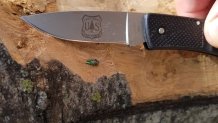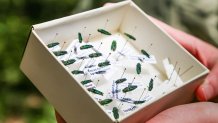After being found last month in Dallas' Great Trinity Forest, the invasive emerald ash borer beetle is now also confirmed to be in four more North Texas counties.
The Texas A&M Forest Service confirmed Monday that beetle samples collected in May in Collin, Franklin, Johnson and Red River counties were all confirmed by the USDA Department of Animal and Plant Health Inspection Service to be the emerald ash borer.
The non-native small green beetle devastates ash tree populations, boring its way into its bark where it lays eggs. The beetle's larvae eventually feed on the tree's water-conducting tissue, slowly killing the tree.
Just last month the beetle was found in Grayson, Hill, Hood, McLennan and Palo Pinto counties.
Get top local stories in DFW delivered to you every morning. Sign up for NBC DFW's News Headlines newsletter.
“The continuous spread of EAB is a great concern for our ash tree population,” said Allen Smith, Texas A&M Forest Service Regional Forest Health Coordinator. “EAB has the potential to wipe out ash as a genus in North America, meaning no more ash trees period.”

Once the presence of EAB is confirmed in a county, the Texas Department of Agriculture steps in and establishes a quarantine that restricts movement of any woody ash material from exiting the county, though it can be moved to other counties also under quarantine.
Texas News
News from around the state of Texas.
“Because EAB is transported unintentionally on firewood and wood products, the quarantine helps slow the beetle’s spread by restricting the movement of wood in and out of affected areas,” said Demian Gomez, Texas A&M Forest Service Regional Forest Health Coordinator.
Dallas, Denton, Parker, and Tarrant counties, all areas where the beetle has also been confirmed, are under the same quarantine.
The Texas A&M Forest Service says both healthy and stressed trees of all ash species are vulnerable to an EAB attack and have no natural resistance to the pest. Most trees will die within two to five years after infestation and without proper proactive measures, mortality can be 100% in areas, so early detection is key.
“There is no known way to stop the spread of EAB,” said Gomez. “But communities can minimize loss, diversify their tree species and increase the health and resiliency of urban forests.”
The beetle may have been first discovered in North Texas in 2018 by a 10-year-old Tarrant County boy who took a picture of the insect because he thought it looked "really weird." The boy uploaded the photo to an online database for naturalists where scientists in other states and countries eventually spotted it, identifying it as a possible emerald ash borer. Experts with the Texas A&M Forest Service were notified and investigated the boy's findings. EAB was first detected in Texas in 2016 in Harrison County (in between Longview, TX and Shreveport, LA)
WHAT IS AN EMERALD ASH BORER?
The emerald ash borer is a small beetle, green in color and smaller than a penny.
The beetle bores its way into the tree's bark and lays eggs. Larvae feed on water-conducting tissue, eventually killing the tree.
Officials said the insect has been confirmed in more than half of the United States and has killed millions of ash trees.
"Both healthy and unhealthy ash trees are susceptible to an EAB attack and may die within two or three years after becoming infested," said Allen Smith, Texas A&M Forest Service regional forest health coordinator, during an interview with NBC 5 in May 2022. "Ash trees have no natural resistance to the exotic insect. Without proper proactive measures, mortality can be 100% in heavily infested areas, so early detection could improve our chances to manage the pest."
Ash trees with low numbers of EAB often have few or no external symptoms of infestations. However, residents can look for signs of EAB among their ash trees, including dead branches near the top of the tree, leafy shoots sprouting from the trunk, bark splits exposing s-shaped larval galleries, extensive woodpecker activities, and D-shaped exit holes.
The beetle was first discovered in North America in 2002 in Michigan. It has since spread to at least 36 states, killing millions of ash trees.
To report emerald ash borer, please call the EAB Hotline at 1-866-322-4512.




